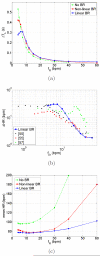Central regulation of heart rate and the appearance of respiratory sinus arrhythmia: new insights from mathematical modeling
- PMID: 25004397
- PMCID: PMC4146737
- DOI: 10.1016/j.mbs.2014.06.015
Central regulation of heart rate and the appearance of respiratory sinus arrhythmia: new insights from mathematical modeling
Abstract
A minimal model for the neural control of heart rate (HR) has been developed with the aim of better understanding respiratory sinus arrhythmia (RSA)--a modulation of HR at the frequency of breathing. This model consists of two differential equations and is integrated into a previously-published model of gas exchange. The heart period is assumed to be affected primarily by the parasympathetic signal, with the sympathetic signal taken as a parameter in the model. We include the baroreflex, mechanical stretch-receptor feedback from the lungs, and central modulation of the cardiac vagal tone by the respiratory drive. Our model mimics a range of experimental observations and provides several new insights. Most notably, the model mimics the growth in the amplitude of RSA with decreasing respiratory frequency up to 7 breaths per minute (for humans). Our model then mimics the decrease in the amplitude of RSA at frequencies below 7 breaths per minute and predicts that this decrease is due to the baroreflex (we show this both numerically and analytically with a linear baroreflex). Another new prediction of the model is that the gating of the baroreflex leads to the dependency of RSA on mean vagal tone. The new model was also used to test two previously-suggested hypotheses regarding the physiological function of RSA and supports the hypothesis that RSA minimizes the work done by the heart while maintaining physiological levels of arterial CO2. These and other new insights the model provides extend our understanding of the integrative nature of vagal control of the heart.
Keywords: Autonomic control; Heart rate; Mathematical model; Respiratory sinus arrhythmia.
Copyright © 2014 Elsevier Inc. All rights reserved.
Figures











References
-
- Spyer KM. Central nervous integration of cardiovascular control. Journal of Experimental Biology. 1982;100(OCT):109–128. - PubMed
-
- Sherwood L. Human physiology : from cells to systems. 2nd Edition West Pub. Co.: 1993.
-
- Bradley TD, Floras JS, editors. Sleep apnea - Implications in cardiovascular and cerebrovascular disease. Marcel Dekker, Inc.; New York: 2000.
-
- Yasuma F, Hayano J. Respiratory sinus arrhythmia - why does the heartbeat synchronize with respiratory rhythm? Chest. 2004;125(2):683–690. - PubMed
-
- Grossman P, Taylor EW. Toward understanding respiratory sinus arrhythmia: Relations to cardiac vagal tone, evolution and biobehavioral functions. Biological Psychology. 2007;74(2):263–285. - PubMed
Publication types
MeSH terms
Grants and funding
LinkOut - more resources
Full Text Sources
Other Literature Sources

